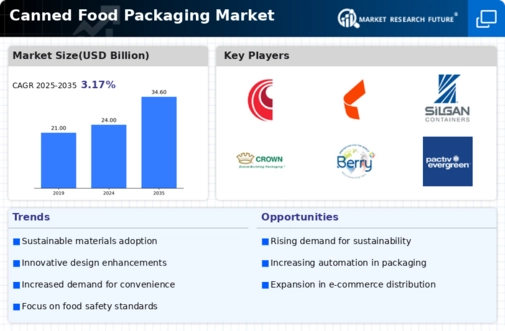Top Industry Leaders in the Canned Food Packaging Market

Canned Food Packaging Market
The canned food packaging market thrives on a complex interplay of established giants and nimble innovators, all vying for a slice of the pie. This market is characterized by:
Market Players:
-
Global Leaders: Crown Holdings, ArcelorMittal, Ball Corporation, Nampak, and Tetra Pak hold significant market share through their vast production capacities, established distribution networks, and diversified product offerings. -
Regional Players: Players like Visy Industries (Asia Pacific), CCL Container (North America), and Toyo Seikan Group Holdings (Japan) cater to specific regional demands and offer competitive pricing. -
Emerging Players: Startups and niche players like Huhtamaki and Canpack are driving innovation with sustainable packaging solutions, eye-catching designs, and specialized formats.
Strategies for Success:
-
Innovation: Continuous improvement in material science, printing technologies, and barrier properties is crucial. Examples include lightweight cans, retort pouches, and bio-based coatings. -
Sustainability: Eco-friendly materials like recycled steel, paper-based cans, and compostable liners are gaining traction, driven by consumer and regulatory pressures. -
Customization: Meeting diverse customer needs with tailor-made solutions for specific food products, portion sizes, and branding requirements. -
Digitalization: Leveraging smart packaging technologies with QR codes, near-field communication (NFC), and blockchain for enhanced product traceability and consumer engagement. -
Geographic Expansion: Targeting emerging markets with high growth potential and adapting product offerings to local preferences.
Factors Influencing Market Share:
-
Production Capacity: Ability to meet the growing demand for canned food packaging requires efficient manufacturing facilities and strategic partnerships. -
Cost Competitiveness: Balancing high-quality materials with competitive pricing is essential, especially in price-sensitive markets. -
Technological Advancement: Investing in R&D to develop innovative and sustainable packaging solutions is key to differentiation. -
Brand Reputation: Building trust and loyalty through consistent quality, ethical sourcing, and commitment to sustainability strengthens market position. -
Regional Regulations: Adapting to evolving regulations on food safety, packaging materials, and recycling mandates is crucial.
List of the Key Companies in the Canned Food Packaging Market Include
- Amcor Ltd.
- Ardagh Group
- CPMC Holdings Ltd.
- Crown Holdings
- Silgan Holdings Inc.
- Toyo Seikan Kaisha Ltd.
- Ball Corporation
- Among others.
Recent Developments:
In 2019, Ball Corporation announced their agreement to sell its tinplate steel aerosol packaging facilities in Garin and San Luis, Argentina, to Envases del Plata S.A.
In the 2019 annual report, JSW Steel reported their decision of increasing their production capacity of tinplates by setting up new mill in Tarapur with capacity of 250,000 tonnes per annum. The company has already setup their tinplate mill with a capacity of 250,000 tonnes per annum in Tarapur during 2018.
In 2019, Ardagh Group announced an agreement to combine its Food & Specialty Metal Packaging business with Exal Corporation to form Trivium Packaging. Trivium Packaging will be headquartered in the Netherlands and will operate with 57 production facilities across Europe and the Americas.
In Aug 2020, Crown Holdings Inc. announced its new initiative called Twentyby30. The company calls for a robust program outlining 20 measurable environmental, social, and governance goals to be completed by 2030 or earlier. The maker of aluminum and steel cans created 20 goals, putting them into five categories Optimum Circularity addressing the usage of recycled content and recycling discarded packaging.
In Sep 2020, Ball Corporation announced building a new United States aluminum beverage packaging plant in Pittston, PA. This multi-line beverage can plant is expected to begin production in mid-2021. This investment supports the company's focus on the rising demand for infinitely recyclable aluminum containers used in spiked seltzer, beer, sparkling water, and carbonated beverage categories.

